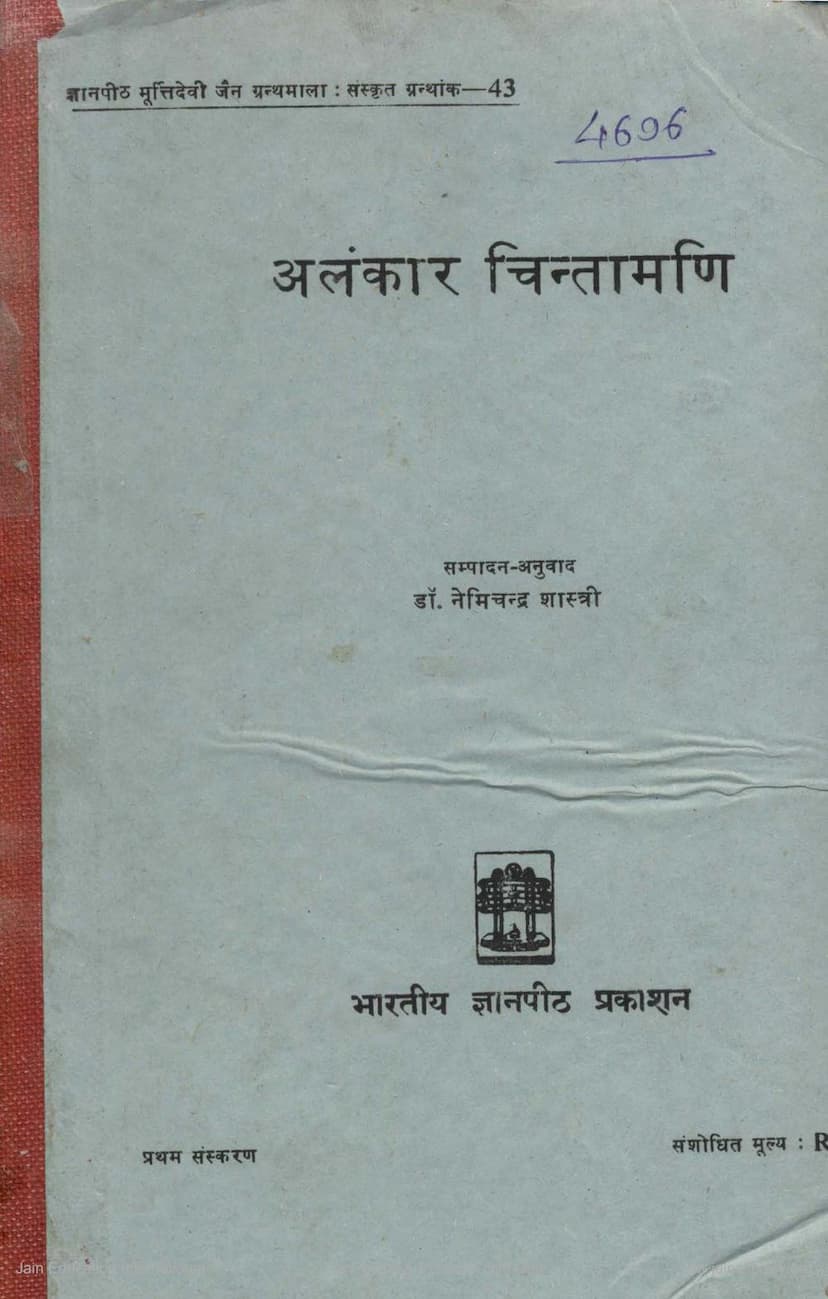Alankar Chintamani
Added to library: September 1, 2025

Summary
Alankar Chintamani: A Comprehensive Summary
Alankar Chintamani, authored by Ajitasena Mahakavi and edited/translated by Dr. Nemi Chandra Shastri, is a significant work in the field of Sanskrit poetics (Alamkara Shastra), with a distinct Jain perspective. Published by Bharatiya Gyanpith, it critically examines various aspects of kavya (poetry) and its constituent elements.
Here's a summary of the key aspects covered in the text, drawing from the provided pages:
1. Author and Period:
- The text clarifies the confusion surrounding the author's identity, confirming Ajitasena as the author, not Jinasena.
- Scholarly debate places Ajitasena's period around the last quarter of the 15th century AD, conflicting with earlier views that placed him earlier. This dating is based on his contemporary, Kamiraya of Bangavadi, whose lineage is established through inscriptions.
2. Publisher and Series:
- The book is published by Bharatiya Jnanpitha as part of the Jnanapeetha Murtidevi Jaina Granthamala: Sanskrit Grantha No. 43.
- The Granthamala is dedicated to critically editing and publishing original Jain Agamic, philosophical, literary, and historical texts in Prakrit, Sanskrit, Apabhramsa, Hindi, Kannada, etc., along with their modern language translations. It also publishes studies on Jain Bhandaras, inscriptions, and popular Jain literature.
3. Content and Structure:
- The Alankar Chintamani is divided into five Paricchedas (chapters), covering a wide range of topics related to poetics:
- Pariccheda I (Kavi-Siksha): Focuses on the education of a poet, including Kavi Samaya (poetic conventions), qualities of a poet, poetic elements, and the description of various subjects and characters suitable for epic poetry. It emphasizes the importance of practice, knowledge, wisdom, and genius for a poet.
- Pariccheda II (Chitra-Alankaras and Bandhas): Discusses decorative figures of speech (Chitra-Alankaras) and complex textual arrangements (Bandhas). It details a remarkable 42 types of Chitra-Alankaras, including intricate formations like Vastavyasta, Sarvatobhadra, Nagapashaka, etc., many of which are presented with their definitions and illustrations.
- Pariccheda III (Shabdalamkaras): Covers other figures of speech besides Chitra-Alankaras, specifically the three Shabdalamkaras: Vakrokti (indirect speech), Anupras (alliteration), and Yamaka (rhyme), detailing Yamaka in its eleven varieties.
- Pariccheda IV (Arthalamkaras): Deals with figures of speech based on meaning (Arthalamkaras). It comprehensively discusses approximately 72 Arthalamkaras, elaborating on their definitions, classifications, and providing examples. The text also delves into the theoretical aspects of Sadhrshya (similarity) and Sadharmya (common quality) in relation to these figures of speech.
- Pariccheda V (Rasa, Riti, Vrutti, Guna, Dosha, Nayaka/Nayika): Covers Rasa (aesthetic sentiment), Riti (poetic style), Vrutti (diction), Guna (qualities), Dosha (defects), and the types of Nayaka (hero) and Nayika (heroine). Notably, the author presents the concepts of Rasa through a Jain philosophical lens, linking them to the Kshaya (subsidence) of karmas. It also elaborates on the characteristics and classification of heroes and heroines.
4. Jain Identity and Influence:
- The text draws illustrations from earlier Puranas (potentially referring to Jinasena's Adipurana), praises Punya-purushas (virtuous individuals), and uses Jain technical terms.
- There are glorifying references to Tirthankaras, and the Jain Karma doctrine is invoked in the exposition of Anubhava (experience) and Samvedana (perception).
- The examples are often drawn from Jain scriptures and praise Shalaka-purushas (illustrious individuals), giving the work a distinct Jain atmosphere.
- Ajitasena references authors like Samantabhadra, Jinasena, Haricandra, Vagbhata, and Vidyānanda, indicating a deep engagement with Jain philosophical and literary traditions.
5. Scholarly Contributions:
- The General Editor, Dr. A. N. Upadhye, acknowledges the versatile scholarship of the editor, Dr. Nemi Chandra Shastri, whose extensive study of Alamkara literature is evident in the valuable introduction.
- The editor, Dr. Nemi Chandra Shastri, critically examined the text based on two manuscripts and one printed edition, providing a Hindi translation and a detailed introduction.
- The text includes a "General Editorial" that provides historical context, discusses previous editions, clarifies authorial dating, and compares Alankar Chintamani with other prominent works on poetics like Bharata's Natya Shastra, Agnipurana, Bhamaha's Kavyalamkara, Dandin's Kavyadarsha, Rajashekhara's Kavyamimamsa, Bhoja's Sarasvati-kanthabharana, Mammata's Kavya-prakasha, and Vagbhata's Valhabhatalamkara.
- The introduction and editorial highlight Ajitasena's unique approach, especially in his detailed treatment of Chitra-Alankaras (42 types) and his nuanced definitions of various figures of speech, often emphasizing the Vibhedaka Pad (discriminating terms) within them.
6. Key Features and Contributions:
- Comprehensive Coverage: The Alankar Chintamani exhaustively deals with the usual topics covered in works on poetics.
- Clarity and Novelty: The text is noted for the clarity of its subject presentation and the originality of its illustrations.
- Traceability of Sources: The availability of a good edition with an index of verses is expected to help scholars trace the sources of Ajitasena's quotations.
- Comparative Study: Dr. Shastri's introduction includes detailed observations on the comparative study of AC with various other works on poetics.
- Alternative Title: The Alankara-Cintamani is also known by the alternative title Bharata-yashas.
- Kannada Expression: Ajitasena uses a Kannada expression in one of his Samasya (riddles), indicating a possible South Indian connection.
In essence, Alankar Chintamani stands out as a significant contribution to the field of Indian poetics, offering a detailed and insightful analysis of poetic elements, enriched by a unique Jain philosophical perspective and Ajitasena's scholarly acumen. The Bharatiya Jnanpith's critical edition makes this valuable text accessible to scholars and students of literature and Jainology.